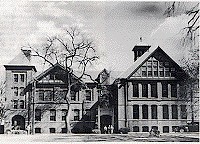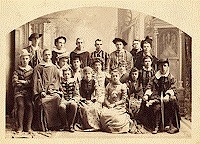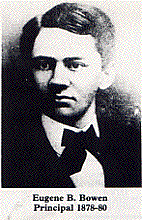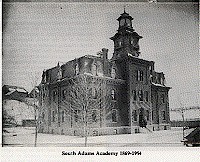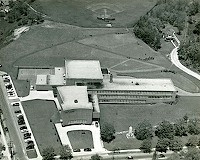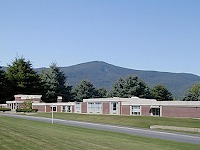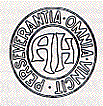reprinted from Adams Historical Society Newsletter, October 1987
The following article is a reprint from the 1952 Yearbook of Adams High School. The first record of any effort to establish a high school in Adams appears in an article in a warrant for a town meeting September 30,1850, "to see whether the town will establish one or more free high schools in said town."
SCHOOL NOTICE
The FREE HIGH SCHOOL at the South Village of Adams will commence its first session on Monday next, the 2nd of December, under the instruction of Daniel B. Briggs, Esq. This school like that at the North Village is established "for the inhabitants of the town" and will be open to all such as are of suitable age and qualifications.
Adams, November 26, 1850, R. Crawford, Sec. of Sch. Com.
Weekly Transcript November, 1850
It was voted to maintain a high school at both the North and South villages, each to be kept 26 weeks each year in suitable places rented for the purpose.
In the winter of 1850-51 the South Adams school was established in the vestry of the Congregational Church, located where Woolworth's now stands, later moved and used as St. Charles Catholic Church, it now constitutes the rear section of the A.H. Simmons furniture store on Park Street. Daniel B. Briggs, a native of Adams, was the first teacher. He was elected to the school committee the following spring and in this capacity played an important part in selecting the students and arranging the program of studies. B.F. Phillips in 1852, the year of his graduation from Williams College, became the second teacher of the high school. He retained the position but for two terms, however. For a few years he formed a small private school of his own, then turned his hand to manufacturing cassimere cloth. He later built a mill for this purpose which still stands in the Maple Grove section. Until the opening of South Adams Academy nineteen years later, eighteen successive teachers, all men, undertook the task of teaching the High School. The subjects established by state law were Latin, Greek, History, algebra, surveying, geometry, bookkeeping, physiology, rhetoric and logic. Scholars were extremely irregular in attendance. On days when farm tasks were not too pressing, they came to school but were not always prepared to recite. Desks were arranged around three sides of the room. The scholars sat facing the wall. Since they were required to furnish their own chairs, pupils sometimes brought rocking chairs to school and often napped while the teacher was hearing the recitation of another form. A wood stove in the middle of the room constituted the heating apparatus. Final examinations, which were conducted by the school committee, extended over a three day period and were open to the public. They were intended primarily to convince reluctant taxpayers that their money was not being wasted. From the Congregational vestry the High School moved to the vestry of the newly-built Baptist Church, then to a hall over the store of D.J. Dean, located in a building just south of the Greylock Hotel on Center Street. In 1856 it was moved again, this time to the vestry of the Methodist Church, now Buster's Filling Station (currently the bottle redemption store) on Commercial Street, and from the latter place to the new Academy building.
POST BELLUM GROWTH
The end of the Civil War saw important changes take place. The town meeting voted to replace the numerous one-room common school spread about the village with the graded system. To instrument this decision the South Adams Academy was erected in1868-69. The school year was lengthened from two terms of thirteen weeks each to three terms of thirteen weeks each. A four year course of study was adopted for the High School with promotions and graduation at the end of the fall term. A preparatory grade, referred to as the ninth, lengthened the formal schooling available at public expense to thirteen grades. Not until 1917 was the formal schooling reduced to twelve when the first grade became known as kindergarten. With the new quarters in the Academy building, the High School teacher, W.W. Spaulding, acquired the additional titles of Superintendent of the graded schools and Principal of the High School. He was no longer alone, for his staff comprised an assistant as well as part-time instructors in French and Music. The compulsory attendance law (three months a year, ages five to thirteen) was poorly enforced. It was difficult with only a sixty percent attendance to maintain scholastic standards. This was done by rigid entrance examinations and enforcement of the following rule: "Any pupil in the High School whose per cent shall be below eighty during two successive months or below seventy for any month, shall be reported for assignment to a lower class."
FIRST GRADUATES
The first to complete the ambitious course of study prescribed by the school committee were Mary L. Sayles and Mary L. Dean in the year 1871. To them goes the honor of being the first graduates of Adams High School. Although there had been previous to this a high school in both the North and South villages for twenty-one years, there had been no graduates. Of the few scholars, many had been little more than occasional visitors. The others either had discontinued their schooling or had been accepted by colleges or academies before satisfying the requirements for graduation. Children of wealthier families had been tutored and attended small private schools to supplement what they learned in the free high school. Thus they were able to gain admission to at least the preparatory department of a college.
1878
In 1878 Adams and North Adams became two separate towns. In the same year Adams divided the dual responsibility of school management. The school committee named W.P. Beckwith Superintendent of Schools and classical instructor in the High School and Eugene Bowen of Cheshire, principal. He claims the distinction of being the first principal of the newly constituted township and the first to give his entire attention to the position.
Over a period of eighteen years Superintendent Beckwith grappled with the problem of getting more children to avail themselves of the opportunity for a free high school education. In 1880 the population of Adams was 5,593. The average membership of the High School was twenty-eight students. In his report of 1886 Mr. Beckwith points out that of the sixty-four graduates to date, thirty had at some time or other been teachers in the Adams school system.
Not only did the High School supply the town with teachers, but undergraduates were called upon to substitute for teachers who were ill. As late as 1910 it was not uncommon for students to leave school in their Junior year to accept positions as teachers in neighboring hill towns.
Rapid growth of the town between 1880 and 1890 necessitated the building of three more graded schools. The added responsibility made it necessary to relieve the superintendent of his teaching duties in the High School. At that time the Academy had an enrollment of 460 and the High School was occupying the south half of the third floor. It was evident that it would soon need a building of its own. Adjoining land was purchased in 1890 and between May, 1890 and February, 1891 was erected the first school building in Adams designed purely for high school purposes. Soon after the building was completed, it was deemed advisable to follow educational trends and offer courses five periods a week instead of three. It was a simple matter to add extra teachers to the faculty but not so simple to find classrooms for them. Space was not available in the basement because the building was being heated by six hot air furnaces. The small assembly room on the second floor originally intended for ninety students was pressed into service as a recitation room and study hall.
In 1898, a one session day was adopted. School kept from 8:30 to 1:15 with a detention period from three to four o'clock. The recess periods had been discontinued when the High School had moved to its own building, but otherwise the schedule had remained the same as for the grade school, nine to twelve and one thirty to four o'clock.
John C. Hull, principal from 1895 to 1902, instituted the commercial course in 1901. He was also instrumental in raising by subscription sufficient funds to purchase pictures and statues to decorate the classrooms. His successor, Charles A. Adams, who was principal until June 1907 is notable for having encouraged such extracurricular activities as the first school orchestra (1903), the first girls' glee club and the first A.A.A.Constitution in 1906. In 1904 the teaching of Greek was discontinued. Between 1904 and 1906 the custom of giving a Senior play became firmly established although many classes had presented plays before. In May of 1892 the Senior class staged "The Merchant of Venice" at the Opera House (the upstairs of the Town Hall) and made a profit of one hundred dollars.
In 1908 the population of Adams was approximately the same as it is today. The High School building designed for 150 pupils then had an enrollment of 190.
As a first step in expansion, the twelve hot air furnaces in the basements of the Liberty Street Grade School and the High School were replaced by a separate underground heating plant with two steam boilers. In both buildings was installed a direct and indirect heating and ventilating system with thermostatic control.
During 1909 the High School was remodeled and enlarged. The remodeling involved removing all partitions on the second floor to provide an assembly room capable of seating 450 people and a stage with two small dressing rooms. The first floor was changed to provide a typing room, a classroom, a library, a reception room, a retiring room for teachers, and offices for the principal and superintendent. In the basement of the original section a lunch counter and lunch room proved a welcome adjunct to the one session day. The basement of the new section afforded ample space for a manual training shop and a domestic arts department. These courses were added to the curriculum in 1912. The new physics and chemistry laboratories on the third floor of the annex had an even more important effect on the curriculum. They provided the first adequate facilities for scientific studies.
In 1909 the town of Cheshire discontinued its High School and its students were sent as tuition pupils to the now "spacious halls" of Adams High.
Until 1951, changes to the building were minor and infrequent. In 1937 wardrobes in the first and second floor corridors were removed. In 1938, John J. Grosz, then teacher of chemistry and physics, installed a loud speaker system to enable the principal to speak to the entire school without an assembly.
